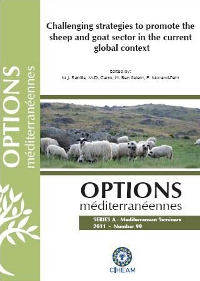| Article précédent | p. 91-96 | Article suivant |
In vitro predation of pure bacterial species by rumen protozoa from monofaunated sheep, determined by qPCR
Predation of bacteria has important implications on rumen microbial ecology and metabolism. The predation rate of bacteria by protozoa in vitro was studied by bacterial DNA quantification. Entodinium caudatum (EC), Diplodinium dentatum (DD) and Metadinium medium (MM) from monofaunated sheep rumen contents were incubated with two pure cultures of bacteria: the fibrolytic Ruminococcus albus (Ra) and the amylolytic Streptococcus bovis (Sb). Total bacterial and protozoal numbers were counted in the media by microscopy, and concentration of Ra, Sb and total bacterial DNA was measured in the protozoal fraction as an index of predation. No differences (P>0.10) were observed in the proportion of DNA from Ra in the different protozoal fractions, but MM predated a higher amount of total bacteria than EC (P=0.045). Proportion of Ra and Sb in the protozoal fraction agrees with that in the medium, precluding selective predation. Protozoal fraction from EC showed a higher (P=0.018) proportion of Sb DNA and a lower amount of total bacterial DNA than MM (P<0.001). Total DNA in MM cultures either per number of cells or per cell volume was highest, indicating a higher engulfment ability of this protozoal species. No differences were observed among incubation times in any studied parameter (P>0.10), suggesting that the predation rate of each protozoa was similar to the intracellular digestion rate.
La prédation des bactéries par des protozoaires a des implications importantes sur l'écologie et le métabolisme du rumen. Dans ce travail le taux de prédation des bactéries a été étudié in vitro par PCR quantitative (qPCR). Entodinium caudatum (EC), Diplodinium dentatum (DD) et Metadinium medium (MM) ont été obtenus des moutons monofaunés et ont été incubés avec deux espèces bactériennes : Ruminococcus albus (Ra, fibrolytique) et Streptococcus bovis (Sb, amylolytique). Le dénombrement de bactéries totales et de protozoaires a été effectué dans le milieu par microscopie. La concentration de Ra, Sb et des bactéries totales dans la fraction contenant les protozoaires, mesurée par qPCR, a été utilisée comme indicateur de la prédation. La proportion d'ADN provenant de Ra était la même pour toutes les fractions de protozoaires, pourtant MM présentait une activité prédatrice des bactéries totales plus importante que celle de EC (P=0,045). Les proportions de Ra et Sb dans la fraction de protozoaires et dans le milieu étaient similaires, excluant ainsi la possibilité d'une prédation sélective. La fraction EC présentait une plus haute proportion d'ADN de Sb que celle de MM (P=0,018) avec une moindre quantité d'ADN bactérien total (P<0,001). MM avait un nombre supérieur de copies d'ADN de bactéries totales qu'EC et DD, suggérant une plus grande capacité à avaler des bactéries. En revanche, il n'y a pas eu de différences au niveau du temps d'incubation (P>0,10), suggérant que le taux de prédation est similaire au taux de digestion intracellulaire.
- [ Afficher ]
- [ Télécharger ]
- [ Exporter la citation ]
Vous pouvez télécharger la citation au format :
- [ Imprimer ]
-
Mots-clés
IN VITRO, PCR, BACTERIE DU RUMEN, PREDATION, PROTOZOA DU RUMENCiter cet article
Fuente G. de la, Morgavi D.P., Belanche A., Fondevila M. In vitro predation of pure bacterial species by rumen protozoa from monofaunated sheep, determined by qPCR. In : Ranilla M.J. (ed.), Carro M.D. (ed.), Ben Salem H. (ed.), Morand-Fehr P. (ed.). Challenging strategies to promote the sheep and goat sector in the current global context. Zaragoza : CIHEAM / CSIC / Universidad de León / FAO, 2011. p. 91-96. (Options Méditerranéennes : Série A. Séminaires Méditerranéens; n. 99). 13. International Seminar of the Sub-Network on Nutrition of the FAO-CIHEAM Inter-Regional Cooperative Research and Development Network on Sheep and Goats, 2009/10/14-16, León (Spain). http://om.ciheam.org/om/pdf/a99/00801540.pdf



